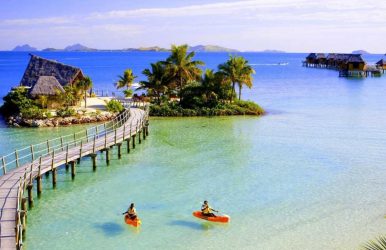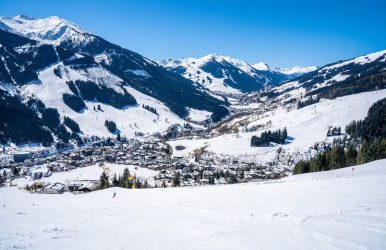February Vacation Ideas for a 9 to 5 Corporate Girlie!
BY sagnika Feb 13, 2025
Whether it is the beaches or the museums, there are several things to explore in the USA! But what is stopping me and you from visiting these places? I don’t know about you but I need to pay my bills you’all! My work often requires me to go to the office Monday to Friday, which makes it difficult for me to go on a trip without any plans! So, I have found a solution, creating a list of February vacation ideas. What's more, I will be sharing these with you so that I can get some realistic feedback on my random impulses! By impulse, let me explain! I am a mix of everything, I love reading a book and vegetating on a chair in front of the sea. While on the other hand, I love putting on my hiking shoes and climbing a hill just to watch that beautiful sunset! Now you know, what I am talking about! Therefore, let me list some ideas that will help you decide on which ones you want to do. This list will also help you identify the type of traveler you are as an individual! You will also get to know about some of the best places to visit in February! Here are the February Vacation Ideas for a Busybody! Either it's chilly or it's just the perfect warm that will create a beautiful environment for your vacation. When considering February vacation ideas, I have some of the coolest ones especially because I keep thinking about them all the time. In the USA, you have several places which offer a variety of activities! You have to consider the temperature behavior along with your budget. If you are someone who is looking for adventure, you might need to keep money aside for adventure sports. Furthermore, if you have planned to visit museums and gardens, walk a lot, and eat local food, well your budget will be much more friendly. Overall, there are specific factors when you are planning vacation ideas, so let me share some of mine! 1. Perform Beach Activities February is a perfect month when a lot of really hot places have the perfect weather! For example, The Keys in Florida has several beaches and night life so does Miami. Additionally, how can we forget about some of the best cruises from Miami? These are the perfect places for my February vacation ideas. With a corporate life giving me back pain, I would love to sprawl across the beach with a book and a drink in my hand. Furthermore, I would also love to try snorkeling and surfing. Sitting on the beach, taking in the view of the Caribbean waters, I can already imagine the sand shining on my toe! One of the coolest beach activities that you can do in February is snorkeling in a sea cave at Captain Cook Kealakekua Bay. Yes, weather plays an important role but if you are lucky, you can encounter whales and wild dolphins. Also, if you visit Hawaii, you can have one of the best experiences of whale watching! Get on a raft boating cruise to watch Whales while on your way to Molokini Crater. 2. Visit Museums, Aquariums, Zoos and Gardens https://www.instagram.com/p/C5ojbOIxKzy/?img_index=1 I am a huge fan of history and animals; hence, I just adore walking around gardens and zoos. Checking out the artifacts and exhibitions is one such hobby of mine and what better way to spend some vacation time in February than doing something I love? Be it, San Diego or Palm Springs, I can visit museums every month if I can manage a day off! Furthermore, as a corporate individual, I am so habituated to sitting on a chair for long periods that I welcome a visit to an aquarium while on a vacation. I visited the Butterfly World once when I went to Coconut Creek, Florida. It is the largest in the world and one of its kind with approximately 20,000 butterflies living there! You must check this out when you are planning a vacation in February with the perfect environment. Another beautiful place you must visit is the North Carolina Aquarium at Fort Fisher! It is a perfect place if you love watching fishes and other mammals in their natural environment. Additionally, you cannot miss the magical Animal Kingdom at Walt Disney when you are traveling with kids. 3. Celebrate Festivals and Events There is a festive feel to February, what’s with the Mardi Gras, Chinese New Year, Valentine's Day, and others. I am all in for festivals and events when it means I can eat, celebrate, and be merry while on vacation. I would prefer to visit New Orleans in February or March so that I can participate in parades, eat rich food, and share laughter and happiness with all. Did you know it is an official state-declared holiday? Well, what could be better than going on a date with my boyfriend while on vacation and ushering in Valentine’s Day? A romantic dinner and sharing some special moments during a vacation seems like the perfect way to relax and enjoy life. When in New Orleans, you can also take one of the best Caribbean cruises offered by Norwegian Cruise Line or Carnival Cruise Line. You will be amazed at the views of the ports like Progreso and Grand Canyon along with inclusive activities. 4. Explore Local Markets, Shopping Centers and Streets If you are someone like me who loves exploring local markets, artisans, and shopping streets, you know what I am going to say. One of the coolest February vacation ideas for me is to stroll around local markets, smell fresh produce, and buy home decor and flowers. Trying out a new pair of sunglasses or a jewelry bit at a local street shop is my perfect way of spending my vacation. With beautiful weather, especially if you visit New York City, you can check out shop displays and splurge on yourself a bit. If you are looking for some affordable shopping, you can visit the Reading Terminal Market and Maui Swap Meet! Furthermore, there are other streets for shopping such as Lincoln Road. Let’s not forget Manhattan in NYC, when talking about shopping! 5. Attempt adventure sports I am a bit of an adventure freak when I want to be! Especially because 9 to 5, my life is so boring, I hunt out for some adrenaline shocks. So why don’t we try bungee jumping in Hansen Bridge, Idaho, or hike a trail in the Sierra Nevada Mountains, California? How about taking a hot air balloon ride at Sedona, Arizona? I have always wanted to go ziplining, so can we try that at Catskills, New York where you can zip at the height of 60 feet across a 3200-foot cable? You can take a hiking tour in the lower Antelope Canyon, Arizona. It can be a little sandy and rocky so be careful about the shoes you choose! There are vibrant passageways creating a kaleidoscope for you when you ascend the canyon! If you want to ski, the perfect destination for you will be Park City Mountain in Utah! Also, Montana has resources where you will get great groomers and can freeride. Another adventure is that you can go on an airboat tour to visit the reptile and alligator exhibit at the Florida Everglades. You can then come back taking one of the best cruises from Florida with delicious BBQ options and an open bar, a perfect night out for a group of friends! Any new Ideas? Why do you think you need February vacation ideas? Guys, seriously! It is one of those months that scream relaxation, adventure, love, and party together. February rolls on like a festival on wheels, you have to take some time off and see the world. And if you are a corporate girlie like me, I know exactly what you need! A two-week vacation that includes a bit of adventure, a bit of fun, and loads of beautiful memories to keep you going for the rest of the year. Comment below on what is your favorite vacation ideas or plans during February and why! Also read Luxury Antarctica Holidays | Beautiful Places In Antarctica. Best Romantic Experiences In Orlando | A Travel Guide For Couples. You Cannot Miss These Things To Do In Wilmington, NC (With Tour And Travel Tips And Tricks)












